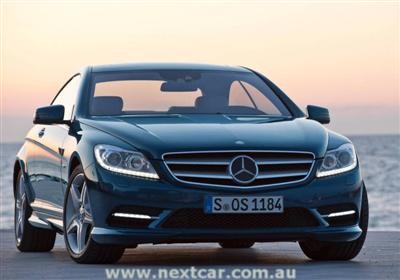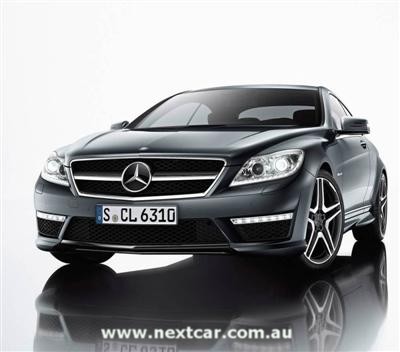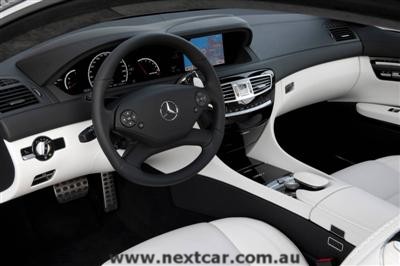Mercedes-Benz CL-Class arrives this month
|
 Mercedes-Benz CL 500
Mercedes-Benz CL 500
|
|
|
Home >
News >
Mercedes-Benz
7th November, 2010
With a design perfected through an immaculate sense of style, highly
exclusive appointments and cutting-edge technology, the extensively updated Mercedes-Benz CL-Class underscores its
claim to supremacy as the summit of automotive refinement.
With the new CL-Class, the Stuttgart-based car maker focuses on fuel consumption and exhaust gas emissions in the
exclusive high-end segment, too. According to Dr Dieter Zetsche, Chairman of the Board of Management of Daimler AG:
“The CL is the ideal ambassador for our brand. It combines in a particular degree those things that characterise
Mercedes-Benz: fascination, perfection and responsibility. And with the new generation we have gone a step further,
too – especially in the realm of efficiency. But in terms of design, safety, comfort and output, too – the CL shows
the way forward: simply follow Mercedes.”
In addition, a combination of cutting-edge camera and radar-based assistance systems unique in the luxury coupé
segment, including the innovation of the Active Lane Assist and Active Blind Spot Assist systems, makes of the
CL-Class a "thinking" partner of the driver. The modified Active Body Control (ABC) with crosswind stabilisation
system and the Direct-Steer system also contribute to enhancing safety and driving enjoyment.
Design: a 'muscular', self-assured presence
The exterior appearance of the new CL-Class generation is characterised by the redesigned bonnet, the dynamic
V-shape radiator grille and the curving headlamps – design details that discreetly but effectively emphasise the
car's elegant yet powerful lines.
The front bumper, too, presents a new design with three air intake openings and a chrome trim strip. An LED strip
with chrome surround for the daytime running lights is elegantly integrated in the side openings for the brake
cooling air. With their standard-fit Intelligent Light System (ILS) and Adaptive Highbeam Assist, the headlamps offer
state-of-the-art illumination technology. The latest LED technology in the turn indicators and position marker lamps
rounds off the car's advanced image. The rear of the vehicle is characterised by the newly-designed tail lamps.
New V8 bi-turbo engine with innovative technology
The new-generation CL-Class also assumes a pioneering role in the drive system sector. Under the bonnet of the CL
500 BlueEFFICIENCY is a new V8 biturbo engine with BlueDIRECT technology which delivers its impressive power. With
its 4,663 cc displacement, the eight-cylinder engine produces 320 kW so that despite 0.8 litres less displacement, it
is still around 12 per cent more powerful than its predecessor, which had an output of 285 kW. At the same time,
torque was raised from 530 Nm to 700 Nm – an increase of 32 per cent. Combined consumption on the other hand, drops
by 23 per cent to 9.5 litres of premium petrol per 100 kilometres. CO2 emissions consequently sink from 288 grammes
per kilometre to 224 grammes per kilometre. (Fuel consumption and CO2 figres are NEDC, Australian figures subject to
confirmation). The CL 500 BlueEFFICIENCY requires a mere 4.9 seconds to accelerate from a standstill to 100 km/h
(previous model: 5.4 seconds). Summing up: the CL 500 BlueEFFICIENCY is significantly more agile, torquey and
thriftier than its predecessor.
The BlueDIRECT technology package of the V8 biturbo includes a series of new developments, unique in their
combination. Worthy of mention among these is the third-generation spray-guided direct petrol injection with piezo
injectors and multi-spark ignition with up to four ignition sparks within a millisecond. Together both enable an
innovative combustion process called "homogenous split". Other factors contributing to the exemplary low fuel
consumption continue to be the consistent use of friction-optimised pistons, piston rings and cylinder barrels, the
on-demand control of oil pump and the new three-phase thermal management in the coolant circuit. The luxury coupé's
package includes the ECO start/stop function and alternator control in accordance with the handling situation and
on-board voltage with kinetic energy recuperation in overrun mode.
The CL 600, with its 380 kW 12-cylinder biturbo engine remains the top-of-the-line model: it accelerates the
luxury coupé from a standstill to 100 km/h in breath-taking 4.6 seconds and now also complies with the Euro 5
emissions control standard.
A unique combination of driver-assistance systems
The new-generation CL-Class consolidates its position as an automotive masterwork and a technology platform of
the Stuttgart-based company with the most advanced assistance and protection systems. These highly perceptive
assistants convert the Mercedes model into a "thinking" partner that can see, feel and react instantly if it detects
a hazard, acting autonomously to prevent accidents or to mitigate their effects. The trailblazing driver assistance
systems in the CL-Class are based on state-of-the-art radar, camera and sensor technology.
Thus, in the new-generation CL-Class Active Lane Keeping Assist celebrates its premiere (at the same time as in
the S-Class). If the vehicle threatens to cross a continuous lane marking line, the system actuates an electric
motor in the steering wheel, causing it to vibrate briefly – giving the driver a discreet but effective warning hint
to countersteer immediately. The active system springs into action if the Mercedes coupé unintentionally crosses a
continuous lane marking line to the right or to the left. In this case, it intervenes by gently braking the wheels
of the opposite side of the car, helping the driver to stay in the lane. In order to do this Active Lane Keeping
Assist avails itself of the ESP® Electronic Stability Programme.
Active Lane-Keeping Assist evaluates information provided by a camera mounted on the inside of the windscreen. It
identifies the contrast between the road surface and the lane marking lines. In addition to this, using radar the
system scans the side of the roadway for crash barriers and other roadway edge markings. This Mercedes assistance
system also evaluates the driver's actions and can thus reliably determine whether the car is departing from the
lane intentionally or not. For this reason, there is no warning if the driver accelerates hard just before
overtaking or when accessing a motorway, or if he brakes hard or steers into a curve.
Targeted brake actuation: active Blind Spot Assist
A further innovation Mercedes-Benz offers for the CL-Class is active Blind Spot Assist, a system that makes use
of a multi-stage warning concept. If it detects that a change of lane would be too dangerous, it warns the driver
by displaying a red triangle in the glass of the exterior mirror. Close-range radar sensors monitor the area
immediately to the side and to the rear of the car. If the driver disregards this warning and, for example,
actuates the turn indicator, an audible warning also sounds. If the driver continues to ignore the warnings and
comes dangerously close to a vehicle in the neighbouring lane, a novel feature of the system acts: a corrective
braking intervention via ESP® on the wheels of the opposite side of the vehicle. This causes a yaw movement about
the car's vertical axis due to the unequal distribution of the braking forces. If despite this course correction
an accident cannot be avoided, the active Blind Spot Assist system can reduce the consequences of a collision
through the brake actuation.
Active Body Control reduces the effect of a crosswind
The Mercedes-Benz CL-Class also meets the highest standards in terms of driving dynamics and agility. This is in
part thanks to Direct-Steer, with a steering ratio that varies with the steering angle, and modified Active Body
Control (ABC) with crosswind stabilisation (standard for CL 500 BlueEFFICIENCY and CL 600). This latest stage in
active body development modifies the wheel load distribution via the ABC spring struts within milliseconds,
depending on crosswind direction and intensity, to the extent that it can largely compensate the effects of the
crosswind.
The Active Body Control suspension system with which Mercedes-Benz ushered in new dimensions of driving dynamics
in the preceding C 215 model series in 1999, is unique worldwide as it not only regulates roll, but pitching and
squatting movements as well, ensuring a perfect harmony of comfort and handling stability.
Since the introduction of this innovative system, engineers in Sindelfingen have continuously improved on it, so
that eleven years later it still marks the summit of automotive engineering. In addition to crosswind stabilisation,
the new suspension features an energy-optimised hydraulic pump that takes part of the burden off the engine,
contributing towards reducing fuel consumption.
Additional safety and agility at the physical limits is provided by the standard-fit Torque Vectoring Brake in
the new-generation CL-Class – targeted, one-sided braking intervention at the inside rear wheel when cornering.
This enables the luxury coupé to turn into the bend under precise control with even greater agility.
|
|
|

Self-Catering Holiday
Accommodation in
Denmark, WA
..... more
|
|
|
Tradition: an exclusive line of ancestors
The new CL-Class continues the great tradition of Mercedes-Benz coupés, which reaches back to the legendary
supercharged cars of the 1920s and '30s. Since the 1950s, in particular, the brand with the three-pointed star
has produced an uninterrupted series of exclusive two-door cars which combine sophisticated design with
trailblazing technology – every model an automotive classic. The W 188 model series 300 S Coupé which entered
series production in 1952 marked the beginning. A contemporary report called it the "measure of what it is
possible to achieve in automotive engineering".
This statement has retained its full validity for all subsequent models, right down to the current CL-Class
of model series C 216, because the luxury coupés from Mercedes-Benz featured - apart from their timeless
design and the highest level of comfort - trailblazing innovations in automotive technology. Thus it was that
in 1961 the 220 SE Coupé was the first series-production Mercedes-Benz to be equipped with disc brakes. In
1995 the ESP Electronic Stability Programme celebrated its world premiere in the S 600 Coupé of model series C
140, and in 1999 the Active Body Control suspension system was introduced for the first time in the CL-Class,
model series C 215. With the PRE-SAFE® brake a further technological innovation made its debut in a large
Mercedes-Benz coupé. In the new CL-Class generation, two new developments, Active Lane Keeping Assist and the
Active Blind Spot Assist, will help prevent accidents or reduce their severity.
News of the AMG versions of the new CL-Class follow the pricing* summary.
Australian pricing* and brief specification
The new CL-Class will celebrate its Australian market launch this month (later arrival for the CL 65 AMG).
The Manufacturer's List Price* (MLP*) is shown as an indication of the pricing* structure.
CL 500 - 4,663 cc, 8-cylinder Bi-Turbo, 320 kW and 700 Nm $337,000*
CL 600 - 5,513 cc, 12-cylinder Bi-Turbo, 380 kW and 830 Nm $425,600*
and the AMG versions:
CL 63 AMG - 5,461 cc, 8-cylinder Bi-Turbo, 400 kW and 800 Nm $423,300*
CL 65 AMG - 5,980 cc, 12-cylinder Bi-Turbo, 463 kW and 1,000 Nm $519,250*
NOTE: * The prices outlined are the Manufacturer’s List Prices (MLP) and, as such, exclude dealer
delivery fees and the state/territory governemnt imposed statutory charges (combined, these add-on amounts are
commonly known as on-road costs). Additionally, prices, fees and/or charges are subject to change without
notice.
... and now the AMG ... wow ...
|
 Mercedes-Benz CL 63 AMG
Mercedes-Benz CL 63 AMG
 Mercedes-Benz CL 63 AMG
Mercedes-Benz CL 63 AMG
|
|
|
The New CL 63 AMG
New design and new high-tech drive system: the Mercedes-Benz CL 63 AMG is to feature a new cutting-edge look
as well as state-of-the-art technology. The stylish visual modifications will be accompanied by a completely
newly developed powertrain. The AMG 5.5-litre V8 biturbo engine in combination with the unique AMG SPEEDSHIFT
MCT 7-speed sports transmission, contributes towards a considerable increase in driving dynamics, while at the
same time guaranteeing a respectable reduction in consumption and emissions.
The new CL 63 AMG marks the start of a new chapter in the "AMG Performance 2015" drive strategy: Mercedes-AMG
is continuing this impressive story and is meeting its promise to continuously reduce both the fuel consumption
and emissions of new models with the new engine/transmission combination – while reaching new heights with the
central AMG brand value of "performance".
According to Ola Källenius, head of Mercedes-AMG GmbH: "We are heading into a new era with the CL 63 AMG:
for the first time we have combined spray-guided direct petrol injection with biturbocharging and the stop/start
system. Together with the AMG SPEEDSHIFT MCT 7-speed sports transmission, we have reduced both fuel consumption
and emissions significantly – while at the same time increasing output and torque."
Together with the AMG SPEEDSHIFT MCT 7-speed sports transmission, the new AMG 5.5-litre V8 biturbo engine
will play a significant role in the Mercedes-AMG model strategy over the coming year. The new engine/transmission
combination marks a further milestone in the successful history of Mercedes-AMG, which began back in 1967.
Direct petrol injection and twin turbocharging
Designated internally as the M157, the new V8 engine is a prime example of efficiency and features a whole
host of impressive technological highlights: for the first time Mercedes-AMG is taking advantage of direct petrol
injection with spray-guided combustion and piezo injectors. This technology enables improved fuel economy thanks
to higher thermodynamic efficiency, which in turns leads to lower exhaust emissions. AMG has combined the
spray-guided combustion with biturbocharging. Other highlights of the innovative, original eight-cylinder
engine from Affalterbach include full aluminium crankcase, four-valve technology with variable intake valve
timing, air/water charge air cooling, generator management and also standard start/stop function. Compared with
the AMG 6.2-litre naturally aspirated V8 engine with a displacement of 6,208 cc, the new AMG 5.5-litre V8 biturbo
engine achieves all this with a displacement of 5,461 cc.
This high-tech package leads to a high output and torque yield, together with fuel consumption figures that
are unrivalled in the competitive line-up. The AMG 5.5-litre V8 biturbo engine develops a peak output of 400 kW
and maximum torque of 800 Nm.
Quantum leap: fuel consumption reduced by 25 per cent (NEDC figures)
With a fuel consumption of 10.5 litres per 100 kilometres, the new CL 63 AMG is 3.9 litres more economical
than the previous model powered by the naturally aspirated AMG 6.2-litre V8 – despite an increase in maximum
power of 14 kW and in torque of 170 Nm. Engine specialists consider this achieved fuel saving of more than 25
per cent to be nothing less than a quantum leap. CO2 emissions have likewise been significantly reduced: at
244 grammes per kilometre, the figure is 29 per cent lower than for the previous model.
With figures like these, the new CL 63 AMG is not only considerably better than all its competitors, but
also more fuel-efficient than much less powerful cars in this segment.
Sports car-level performance
The CL 63 AMG accelerates from zero to 100 km/h in 4.5 seconds, and has an electronically limited top speed
of 250 km/h.
It is not only the unrivalled torque delivery of this turbocharged eight-cylinder that makes the heart beat
faster, as the agile responsiveness with no irritating charger delay also leads to an effortlessness and
dynamism previously unknown in this output class. All perfectly matched by the characteristic and powerful,
sonorous engine note. Moreover, this AMG high-performance engine naturally meets all the requirements with
respect to smooth, quiet running and the comfort on long journeys that is to be expected of a Mercedes.
Australian Pricing and Specification
The new CL 63 AMG will also celebrate its Australian market launch this month. Prices* are indicated in the
final paragraphs of our story on the release of the new Mercedes-Benz CL-Class (just above the CL 63 AMG
images).
Engine production – tradition of hand-built excellence
Like all other AMG engines, the new eight-cylinder biturbo is assembled by hand in the AMG engine shop
taken into commission in 2002. Highly-qualified technicians assemble the M157 according to the "one man, one
engine" philosophy, maintaining the very strictest quality standards. This painstaking care is attested to by
the signature on the characteristic AMG engine plate.
|